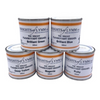Gold Leaf Across the World - Hungary
- by Sam Wozniak
The Gilded Heritage of Hungary: A Deep Dive into Gold Leaf Art and Restoration
Hungary, with its layered history and architectural richness, has long embraced the beauty and symbolism of gold leaf (aranyfüst). From medieval churches to Art Nouveau masterpieces, gilding (aranyozás) has been central to expressing power, divinity, and aesthetic excellence in Hungarian art and design. Today, both 23.5 carat (23,5 karátos) and 24 carat (24 karátos) gold leaf remain essential in restoration (restaurálás) work and contemporary applications — continuing a tradition that spans centuries.
Medieval Beginnings: Gold Leaf in Religious Hungary
The use of goldleaf (aranyfüst) in Hungary dates back to the Middle Ages, when Christianity began to shape the cultural landscape of the Kingdom of Hungary. Monasteries, cathedrals, and royal chapels featured lavish interior decoration, often incorporating gold leaf on altarpieces, manuscript illuminations, and ecclesiastical icons.
Gilded decorations symbolized divine light and heavenly presence. Artisans used 24 carat gold leaf (24 karátos aranyfüst) for sacred objects because of its purity and unparalleled brilliance, which they believed best represented spiritual perfection.
Baroque and Monumental Gilding Across Hungary
The Baroque period brought a wave of monumental (monumentális) architecture and exuberant ornamentation to Hungary, particularly under Habsburg rule. Churches, palaces, and government buildings in cities like Eger, Győr, and Budapest were richly adorned with gilded stucco, wood carvings, and ceilings.
This era saw the widespread use of 23.5 carat gold leaf (23,5 karátos aranyfüst), which provided a balance of purity and durability — especially for surfaces like wood, stone, and plaster. In structures such as the St. Stephen's Basilica in Budapest or the Esztergom Basilica, gilding elevated the interiors to a level of grandeur that reflected both divine and imperial authority.
Gilding in Secular Art and Folk Traditions
While much of Hungary’s gold leaf legacy is tied to religious buildings, aranyozás also found its way into aristocratic homes, ceremonial furniture, and traditional Hungarian folk art. Picture frames, mirrors, and woodwork were often gilded to convey elegance and refinement.
Gold leaf was also applied to leather bindings, instruments, and ceremonial objects, showcasing the versatility of goldleaf (aranyfüst) in cultural and everyday contexts. Even today, traditional Hungarian craftspeople in regions like Kalocsa and Hollókő incorporate gold leaf in decorative elements of folk costumes and religious icons.
The Role of Gold Leaf in Restoration Work
Modern Hungary has placed increasing importance on the restoration (restaurálás) of its historic buildings and artworks. Skilled artisans trained in heritage preservation use authentic gilding techniques and materials — including both 23.5 carat and 24 carat gold leaf — to revive faded splendour.
Recent high-profile restoration projects, such as the renewal of Buda Castle, Matthias Church, and parts of Parliament, have relied on gold leaf to bring back the authenticity of historic interiors and sculptures. Restorers use a combination of traditional water gilding (for wooden elements) and oil gilding (for architectural surfaces) to match original techniques and finishes.
Gold Leaf in Contemporary Hungarian Art and Design
Beyond preservation, Hungarian artists and designers continue to explore the creative potential of gold leaf (aranyfüst) in modern contexts. From contemporary paintings and mixed media to fashion and interior design, gilding adds depth, symbolism, and luxury.
Several Budapest-based studios specialize in custom gilding (aranyozás), offering everything from handcrafted signage to luxury home décor using 23,5 karátos aranyfüst and edible gold for culinary applications. This fusion of tradition and innovation keeps gold leaf relevant in Hungary’s visual and material culture.
Conclusion: Hungary’s Enduring Golden Legacy
The story of gold leaf (aranyfüst) in Hungary is one of beauty, heritage, and continuity. Whether applied to monumental religious spaces, royal palaces, or contemporary artworks, gold leaf represents a commitment to craft, symbolism, and national pride. Through careful restoration (restaurálás) and modern adaptation, Hungary continues to shine — literally and culturally — with the enduring glow of 23.5 carat and 24 carat goldleaf.






